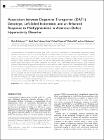| dc.contributor.author | GILL, MICHAEL | en |
| dc.contributor.author | HAWI, ZIARIH | en |
| dc.contributor.author | ROBERTSON, IAN | en |
| dc.contributor.author | FITZGERALD, MICHAEL | en |
| dc.date.accessioned | 2009-12-01T12:17:12Z | |
| dc.date.available | 2009-12-01T12:17:12Z | |
| dc.date.issued | 2005 | en |
| dc.date.submitted | 2005 | en |
| dc.identifier.citation | Bellgrove M.A., Gill M, Hawi Z, Kirley A, Fitzgerald M. Robertson I.H., Association between dopamine transporter (DAT1)genotype, left sided inattention, and an enhanced response to methylphenidate in attention deficit hyperactivity disorder, Neuropsychopharmacology : official publication of the American College of Neuropsychopharmacology, 30, 12, 2005, 2290 - 2297 | en |
| dc.identifier.other | Y | en |
| dc.identifier.uri | http://hdl.handle.net/2262/35088 | |
| dc.description | PUBLISHED | en |
| dc.description | (212) PMID: 16123773 ABSTRACT: Polymorphism of the dopamine transporter gene (DAT1, 10-repeat) is associated with attention-deficit hyperactivity disorder (ADHD) and has been linked to an enhanced response to methylphenidate (MPH). One aspect of the attention deficit in ADHD includes a subtle inattention to left space, resembling that seen after right cerebral hemisphere damage. Since left-sided inattention in ADHD may resolve when treated with MPH, we asked whether left-sided inattention in ADHD was related to DAT1 genotype and the therapeutic efficacy of MPH. A total of 43 ADHD children and their parents were genotyped for the DAT1 3' variable number of tandem repeats polymorphism. The children performed the Landmark Test, a well-validated measure yielding a spatial attentional asymmetry index (leftward to rightward attentional bias). Parents rated their child's response to MPH retrospectively using a three-point scale (no, mediocre or very good response). Additionally, parents used a symptom checklist to rate behavior while on and off medication. A within-family control design determined whether asymmetry indices predicted biased transmission of 10-repeat parental DAT1 alleles and/or response to MPH. It was found that left-sided inattention predicted transmission of the 10-repeat allele from parents to probands and was associated with the severity of ADHD symptomatology. Children rated as achieving a very good response to MPH displayed left-sided inattention, while those rated as achieving a poorer response did not. Our results suggest a subgroup of children with ADHD for whom the 10-repeat DAT1 allele is associated with left-sided inattention. MPH may be most efficacious in this group because it ameliorates a DAT1-mediated hypodopaminergic state. | en |
| dc.description.abstract | A polymorphism of the dopamine transporter gene (DAT1, 10-repeat) is associated with attention-deficit hyperactivity disorder (ADHD) and has been linked to an enhanced response to methylphenidate (MPH). One aspect of the attention deficit in ADHD includes a subtle inattention to left space, resembling that seen after right cerebral hemisphere damage. Since left-sided inattention in ADHD may resolve when treated with MPH, we asked whether left-sided inattention in ADHD was related to DAT1 genotype and the therapeutic efficacy of MPH. A total of 43 ADHD children and their parents were genotyped for the DAT1 3' variable number of tandem repeats polymorphism. The children performed the Landmark Test, a well-validated measure yielding a spatial attentional asymmetry index (leftward to rightward attentional bias). Parents rated their child's response to MPH retrospectively using a three-point scale (no, mediocre or very good response). Additionally, parents used a symptom checklist to rate behavior while on and off medication. A within-family control design determined whether asymmetry indices predicted biased transmission of 10-repeat parental DAT1 alleles and/or response to MPH. It was found that left-sided inattention predicted transmission of the 10-repeat allele from parents to probands and was associated with the severity of ADHD symptomatology. Children rated as achieving a very good response to MPH displayed left-sided inattention, while those rated as achieving a poorer response did not. Our results suggest a subgroup of children with ADHD for whom the 10-repeat DAT1 allele is associated with left-sided inattention. MPH may be most efficacious in this group because it ameliorates a DAT1-mediated hypodopaminergic state. | en |
| dc.format.extent | 2290 | en |
| dc.format.extent | 2297 | en |
| dc.format.mimetype | application/pdf | |
| dc.language.iso | en | en |
| dc.relation.ispartofseries | Neuropsychopharmacology : official publication of the American College of Neuropsychopharmacology | en |
| dc.relation.ispartofseries | 30 | en |
| dc.relation.ispartofseries | 12 | en |
| dc.rights | Y | en |
| dc.subject | DAT1, dopamine, ADHD, methylphenidate, attention, genetics | en |
| dc.title | Association between dopamine transporter (DAT1)genotype, left sided inattention, and an enhanced response to methylphenidate in attention deficit hyperactivity disorder | en |
| dc.type | Journal Article | en |
| dc.type.supercollection | scholarly_publications | en |
| dc.type.supercollection | refereed_publications | en |
| dc.identifier.peoplefinderurl | http://people.tcd.ie/mgill | en |
| dc.identifier.peoplefinderurl | http://people.tcd.ie/iroberts | en |
| dc.identifier.peoplefinderurl | http://people.tcd.ie/zhhawi | en |
| dc.identifier.peoplefinderurl | http://people.tcd.ie/mifitzge | en |
| dc.identifier.rssinternalid | 33697 | en |
| dc.identifier.doi | http://dx.doi.org/10.1038/sj.npp.1300839 | en |
| dc.subject.TCDTheme | Neuroscience | en |
| dc.subject.TCDTag | ADD/ADHD | en |
| dc.subject.TCDTag | ADD/ADHD | en |
| dc.subject.TCDTag | ADHD | en |
| dc.subject.TCDTag | ADHD | en |
| dc.subject.TCDTag | ATTENTION DEFICIT HYPERACTIVITY DISORDER (ADHD) | en |
| dc.subject.TCDTag | Adolescent Psychiatry | en |
| dc.subject.TCDTag | Attention Deficit Hyperactivity Disorder (ADHD) | en |
| dc.subject.TCDTag | CHILD PSYCHIATRY | en |
| dc.subject.TCDTag | DAT1 | en |
| dc.subject.TCDTag | DISORDER ADHD | en |
| dc.subject.TCDTag | METHYLPHENIDATE | en |
| dc.subject.TCDTag | Neuropsychiatry | en |
| dc.subject.TCDTag | Neuropsychiatry | en |
| dc.subject.TCDTag | PSYCHIATRY | en |
| dc.subject.TCDTag | Psychiatry | en |
| dc.subject.TCDTag | Psychiatry | en |
| dc.subject.TCDTag | child and adolescent Psychiatry | en |
| dc.subject.TCDTag | neurodevelopmental psychiatry | en |
| dc.identifier.rssuri | http://professormichaelfitzgerald.eu/ | en |
| dc.identifier.rssuri | http://www.ncbi.nlm.nih.gov/pubmed/16123773 | en |




